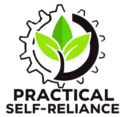Water is essential, especially in emergencies. Having a long-term water storage plan can make all the difference when disaster strikes.
Food-grade barrels are not just any ordinary containers; they are specially designed to keep your water safe and clean for extended periods. Choosing the right barrel is crucial to ensure the water remains uncontaminated and potable.
This guide covers everything you need to know to get started with your emergency preparedness journey, focusing on food-grade barrels that ensure the best quality for your stored water. Get ready to dive into a world of practical tips and tricks that will help you secure your family’s hydration needs!
1. Understanding Food-Grade Barrels
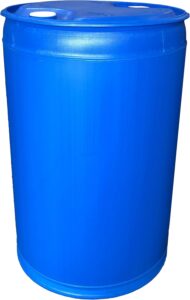
Before you purchase, it’s important to know what food-grade barrels really are. These barrels are made from materials that won’t leach harmful chemicals into the water. Typically, food-grade plastic is certified to be safe for storing consumables. Look for barrels that have been approved by the FDA or similar regulatory bodies.
One excellent option is the Augason Farms 55-Gallon Water Storage Barrel, BPA Free, Emergency Water Supply. This barrel has a substantial capacity and is designed specifically for storing water safely, giving you peace of mind in emergency situations.
Key features to consider include the capacity of the barrel (most commonly 55 gallons) and the presence of an airtight seal to prevent contamination. Additionally, it’s essential to look for BPA-free construction to avoid chemical leaching. For a smaller alternative, the Reliance Products Aqua-Tainer 7 Gallon Rigid Water Container or the AquaBrick 3 Gallon, Stackable Long Term Water Storage Containers. Both are great options. Its compact size makes it easy to transport and store, while still meeting health standards for water storage.
Understanding these basics ensures you invest in a reliable barrel that meets health standards, giving you peace of mind when storing water for emergencies.
2. Selecting the Right Barrel Size
Choosing the right size barrel is essential for your long-term water storage strategy. While 55-gallon barrels like the Augason Farms 55-gallon water storage barrel are the most common, smaller sizes, like the Eagle 30-gallon plastic drum or even the 15-gallon emergency water storage barrel, may be more suitable for families with limited space.
Consider the number of people in your household and how much water you might need over time. The general recommendation is to store at least one gallon of water per person, per day. For example, a family of four will need around 28 gallons for one week. However, it’s also wise to think about your storage conditions and whether you can safely manage larger barrels.
Some points to factor in include:
– Space availability in your home or garage.
– Ease of transport if you need to relocate.
– The duration for which you want the water supply to last.
Selecting the right size barrel today ensures that you won’t face shortages during emergencies. Whether you opt for a larger option like the 55-gallon barrel or a more compact choice like the 15-gallon drum, each product can accommodate various storage needs while ensuring your water remains safe for consumption.
3. Proper Cleaning and Sanitization
Before you use any barrel for water storage, it’s crucial to clean and sanitize it properly. Start by rinsing the barrel with hot water to remove any residue. For effective sanitization, prepare a solution using unscented household bleach, like KIK Pure Bright Ultra Bleach. Mix one tablespoon of bleach per gallon of water and fill the barrel with this solution, ensuring it coats all surfaces.
Let it sit for at least 30 minutes, then drain it and rinse thoroughly with clean water until the bleach smell is gone.
Here’s a quick recap of the cleaning steps:
– Rinse with hot water.
– Create a bleach solution (1 tbsp per gallon).
– Swirl the solution around and let it sit.
– Drain and rinse thoroughly.
Taking the time to clean your barrels properly means that you start with the best possible safety for your long-term water storage.
4. Best Practices for Water Storage
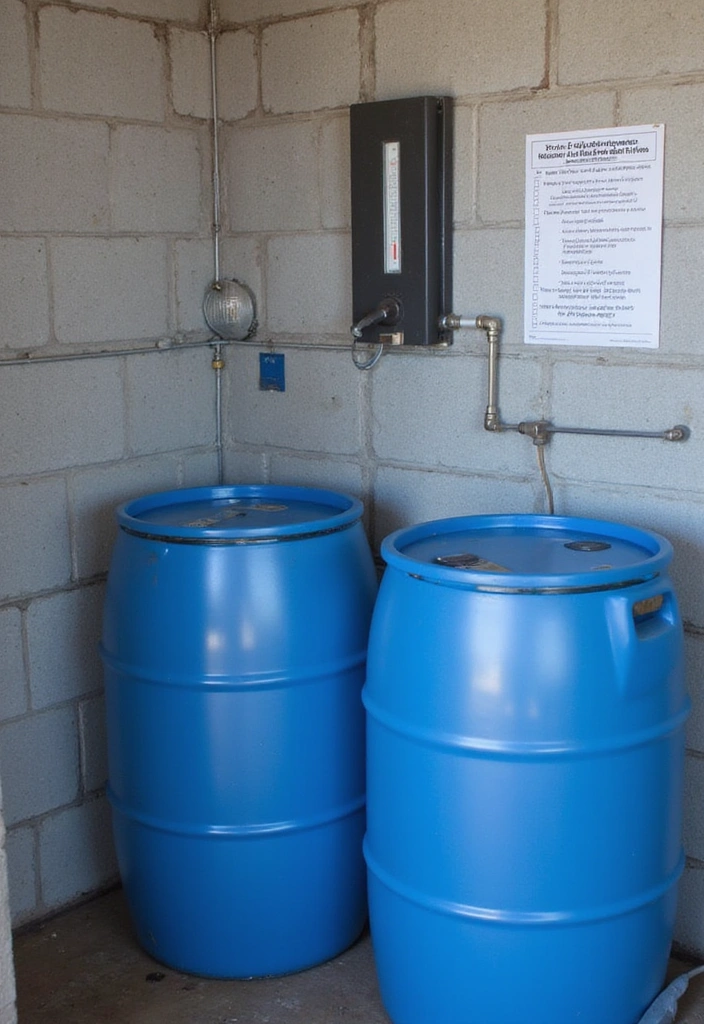
Once you have your clean barrel, it’s time to think about how to store the water effectively. Fill the barrel with potable water, ideally from a trusted source. If tap water is your only option, consider adding unscented bleach, about 1/8 teaspoon per gallon, to help keep it safe.
To ensure the quality of your water during long-term storage, using food-safe water treatment products is crucial. For instance, food-grade water treatment tablets like Aquatabs can provide an easy and effective way to disinfect your water supply, especially during emergencies or when you’re on the go.
Storage conditions matter as well; keep the barrels in a dark, cool area to minimize algae growth and other contaminants. To keep track of the water quality, consider a water quality test kit such as the Varify 17in1 Complete Drinking Water Test Kit. This kit enables you to regularly check for potential issues like lead, chlorine, and bacteria, ensuring that your stored water remains safe to drink.
Additional tips include regularly checking the barrels for leaks or signs of contamination and rotating your water supply every six months to ensure freshness.
Implementing these practices not only maintains the quality of the water but also enhances your overall preparedness plan.
5. Storing Water for Extended Durations
Water can be stored for long periods, but certain techniques are necessary to ensure its quality. Consider breaking up your storage into multiple barrels to allow for easier rotation and access. If you have large barrels, think about filling them partially to make use easier.
Experiment with different storage methods to find what works best for you. Maintaining consistent temperatures is also crucial for preserving water quality. Additionally, having water purification on hand is vital. The Aquatabs 49mg water purification tablets are a convenient solution for treating and disinfecting water for various situations, from camping to emergencies.
If you’re looking for a practical storage option that includes easy access, consider the Rugged stackable water storage tank with spigot. This 55-gallon tank allows for efficient water dispensing and is perfect for storing larger quantities.
Key takeaways include:
– Assess the importance of water rotation.
– Choose dark barrels to limit light exposure.
– Store at consistent temperatures to maintain water quality.
Understanding how to store water long-term prepares you for any situation, giving you a reliable resource when you need it most.
6. Emergency Preparedness Strategies
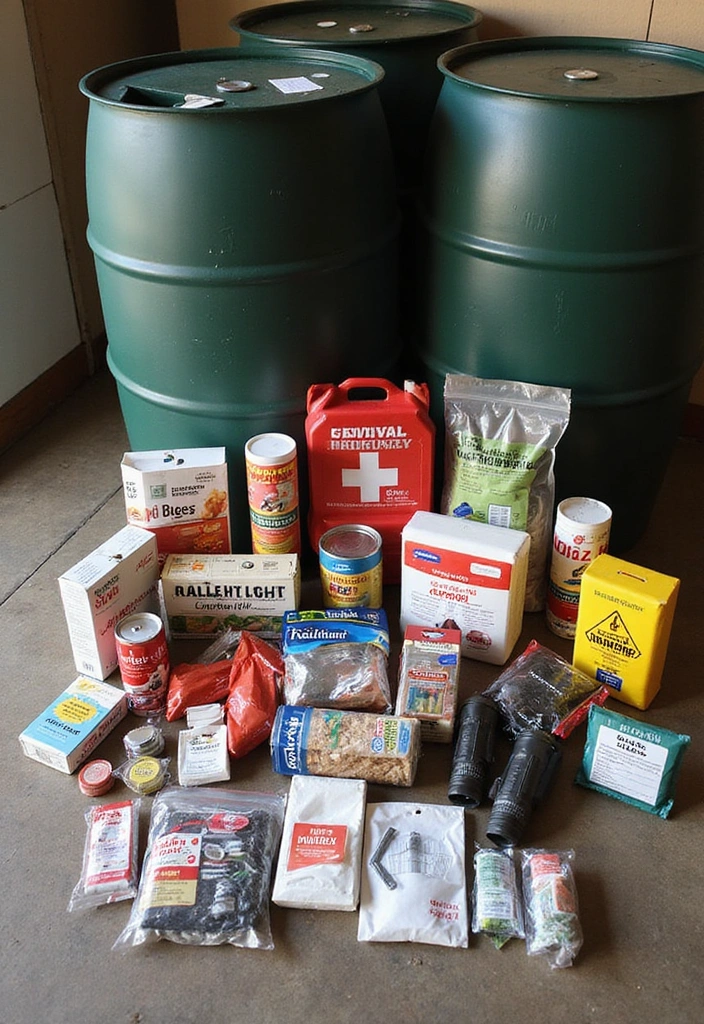
Incorporating your water storage plan into a broader emergency preparedness strategy is essential. Consider other resources you might need, such as non-perishable food, medical supplies, and a reliable communication plan. These elements work together to create a safety net for you and your family.
Engaging your family in the planning process can also foster a sense of teamwork and readiness. Some strategies you may want to adopt include:
– Conducting regular emergency drills.
– Keeping an updated list of emergency contacts.
– Designating a meeting point for family members.
To enhance your preparedness, investing in a few key products can make a big difference. For water storage, the Augason Farms 55-gallon water storage barrel, BPA free is a reliable option. This food-grade barrel is designed specifically for emergency water supply and will ensure you have a clean and safe water source when needed.
In addition to water, having a stockpile of food is crucial. The Heaven’s Harvest 25-year family food kit provides a comprehensive selection of non-perishable meals that are both convenient and designed for long-term storage. With 60 servings, it offers peace of mind in case of emergencies.
Don’t overlook medical needs as part of your preparation. A well-equipped first aid kit for emergency preparedness, like the Care Science First Aid Kit with 110 pieces, is essential for treating injuries that may arise during unexpected situations.
A comprehensive approach to emergency preparedness ensures that you’re not just prepared for water shortages but for any unforeseen circumstances. By integrating these products into your plan, you can feel more secure knowing that you and your family are ready for whatever may come your way.
7. Maintenance and Checking Your Stock
Regular maintenance of your stored water is crucial for safety. Set a reminder to check your barrels every few months for leaks, any signs of discoloration, or foul odors. This helps catch any potential issues before they become serious.
To ensure the water quality remains optimal, it’s wise to test your stored water periodically. The water quality test strips can help you monitor for contaminants like lead, chlorine, and other impurities, giving you peace of mind about your supply.
Implementing a rotation system, where the oldest water is used first, keeps your supply fresh and reliable. A great way to keep track of this is by using water rotation system labels. These labels allow you to mark when each batch of water was stored, ensuring you are always aware of its freshness.
Here’s how to maintain your stock effectively:
– Schedule regular checks on each barrel.
– Rotate your water supply every six months.
– Keep records of your water storage dates with the help of labels to track usage.
Routine maintenance is part of effective preparedness planning, ensuring your supplies are always in top condition.
8. Alternatives to Barrels
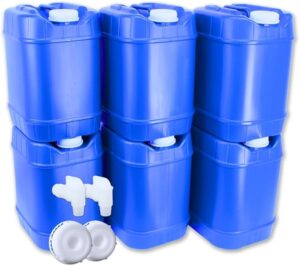
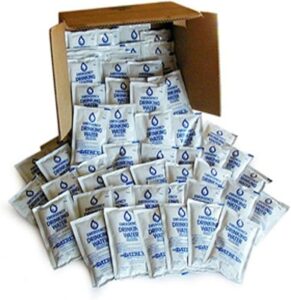
While food-grade barrels are a popular choice for long-term water storage, there are alternative methods worth considering to suit different needs.
For example, collapsible water containers can be a flexible option for smaller needs. These containers are designed for portability, making them easy to pack away until needed while offering convenient access when you’re on the go.
Another option is using a 5 gallon stackable storage system. Glass containers are excellent for preventing chemical leaching, ensuring that your water stays pure and safe for consumption over extended periods.
If you’re looking for a quick and convenient solution, consider pre-packaged water pouches. These are perfect for single-use situations and are easy to store in emergency kits.
Each alternative has its own set of pros and cons, so evaluating your specific needs is essential. Exploring all your options ensures you find the best solutions for your unique scenario.
9. FAQs About Long-Term Water Storage
Navigating water storage can raise questions, and it’s important to address common concerns.
Some frequently asked questions include: How often should I rotate my water supply? Can I use regular plastic containers? What if my water has a strange taste?
Here are some quick answers:
– Rotate your supply every six months or as needed.
– Avoid using non-food grade containers to prevent contamination. For reliable long-term storage, consider using the Augason Farms 55-gallon water storage barrel, which is BPA free and specifically designed for emergency water supply.
– Strange tastes can often be resolved by proper cleaning or using filters. The Brita water filter pitcher is an excellent option for ensuring your drinking water tastes fresh, as it effectively filters tap water and lasts for two months with each filter.
Additionally, for added peace of mind, consider treating your stored water with water storage treatment tablets. These drops help maintain the quality of water for up to five years, making your emergency storage even more reliable.
By understanding these common questions and utilizing these helpful products, you can feel more confident managing your water storage.
Conclusion
Long-term water storage is a critical part of emergency preparedness that shouldn’t be overlooked. Food-grade barrels can provide a safe, reliable way to ensure your family has access to water when it’s needed most.
By following the tips in this guide, you’ll feel empowered to take charge of your water storage needs and build a solid preparedness plan. Remember, being proactive today means peace of mind tomorrow!
Note: We aim to provide accurate product links, but some may occasionally expire or become unavailable. If this happens, please search directly on Amazon for the product or a suitable alternative.
This post contains Amazon affiliate links, meaning I may earn a small commission if you purchase through my links, at no extra cost to you.
